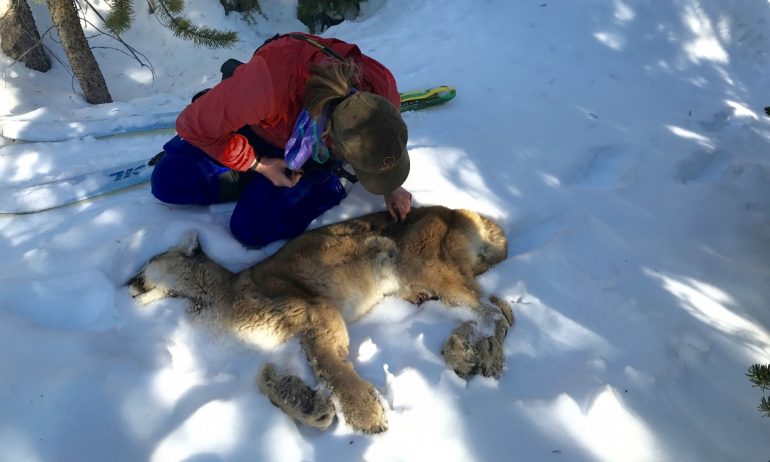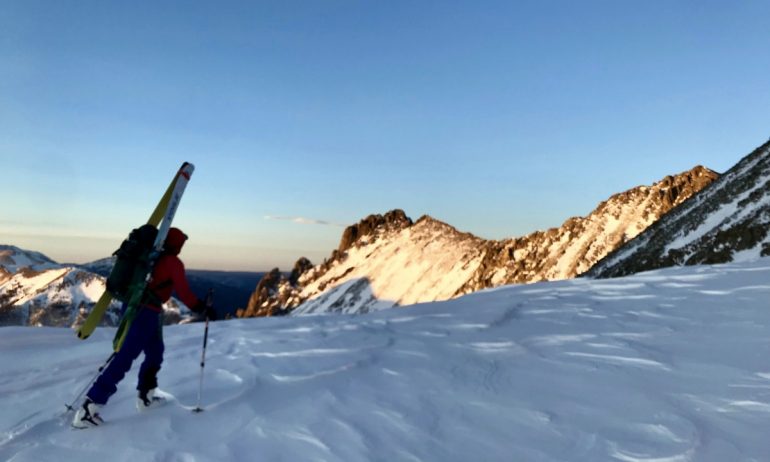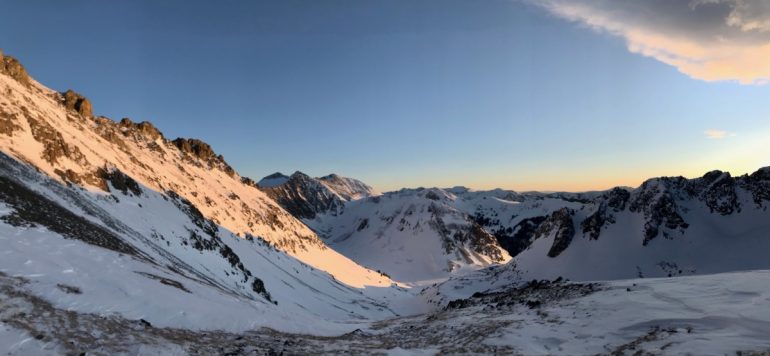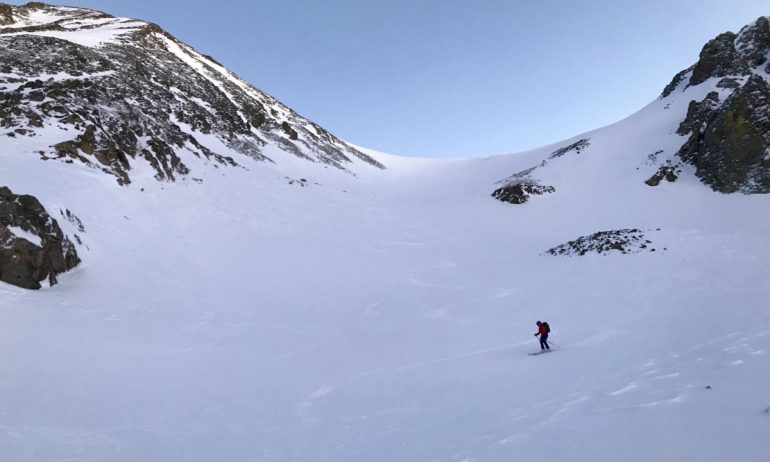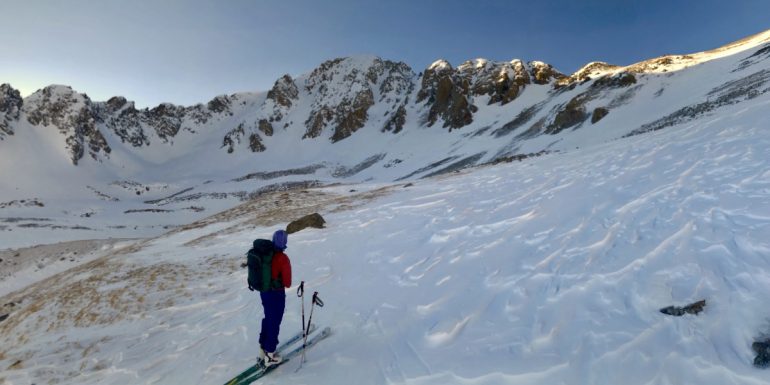
Sam gazes at the ridge chutes adjacent to Mount Mahler as dusk settles on the northern peaks of the Never Summers.
Unexpected findings on an exploratory ski tour
“I’m surprised we haven’t seen any tracks,” my ski partner Sam remarked as we stretched skins on our skis in a snowy meadow near Cameron Pass in Northern Colorado. At first I thought she meant ski tracks, which I was not surprised by given our location in a relatively remote drainage most skiers would have not probable reason to enter. But then it struck me that Sam is a wildlife researcher and follows animal prints for a living. She’d been on the lookout for signs of mountain critters.
We were a couple of hours into a ski tour both of us had long wanted to try in the Never Summer mountains north of Rocky Mountain National Park. The area south of Cameron Pass mostly sees backcountry ski traffic from the Front Range, and from once-grad students like Sam and I, marooned in the Laramie valley of southeast Wyoming. It gives a back door into Rocky Mountain National Park, and a whole host of quiet peaks and valleys. The avalanche danger was low, temps warm, and the day ideal for exploring.
We’d started at the trailhead to the popular Seven Utes zone — an once-proposed ski area that sports a series of delightfully consistent north facing tree runs — and intended to link up with the also popular Agnes Lake zone. We’d skied both areas plenty but never in one day by way of the saddles and drainages that could, according to the map, connect them. Our midday start made it likely we’d finish in the dark, which was fine, even ideal. The link-up was a training ski for the Elk Mountain Grand Traverse. Any simulations close to a through-the-night slog were welcome.
Roughly three miles of skinning brought us to our first saddle at 11,000 feet, just east of Seven Utes Mountain. The afternoon was cloudless with temps in the mid forties. We remarked on how soft and poppy the snow looked in north-facing trees but opted to forego our best chance of powder skiing for the day and dropped instead into the sun-crusted south facing slopes off the saddle. Using the Gaia GPS track we’d outlined the night before as a guide, we descended 900 feet to the meadow and transitioned.
Not long after Sam’s remark on the lack of animals, we spotted something: round paw prints punched into the snow. A light powder dusting had fallen two days before, partially filling the tracks and making the pattern of the paw print impossible to discern. Sam knelt down to investigate. “I think it could be lynx,” she said. “The gait and how big they are…not wolf, not coyote.” We began to follow them.
A small broken branch lay across the prints, which stopped and double backed. Just downslope, more broken branches lay on tamped-down snow. Sam picked up one of the larger sticks, and held it up to the tree it looked to come off of. “Yeah,” she said, eying the distance from the branch to the ground, “a lynx could’ve done that.” The mystery thickened. I followed my gaze farther into an evergreen canopy to where it looked like the tracks had stopped.
Holy crap. “Sam,” I said suddenly, “it’s right in front of us.” In the snow not 20 feet away a furry beige-colored figure laid still on its side.
A mountain lion.
Having lived in Colorado and Wyoming for more than a decade, I’ve heard plenty about the elusive cats. I’ve spotted paw prints while mountain biking. I’ve seen photos of them peering into the sliding glass doors on people’s houses. I’ve heard stories of them stalking trail runners and bikers, and how their powerful jaws can — and do — crush human skulls.
But I’d never seen one in person, especially not so close and so… dead.
The cat lay very peacefully and quietly, her eyes closed, her body stiff and frozen. Sam pointed to a few small legions on her legs, maybe from the branches. “I bet she starved to death,” Sam surmised, her fingers pressing against the bony protrusions of the cat’s pelvis. “It’s especially bad when an animal’s pelvis is this defined.” We continued to look her over, seeking any other signs to indicate how she met her end. We found clues in her nose: broken porcupine quills. More in her mouth, under her jaw, in her shoulders.
Maybe she was so hungry she tried to eat a porcupine, we guessed. Sam grabbed a paw and lifted the body away from the snow. She tugged out the cat’s tail; it was as long as her body. My fingers grazed her paw, as big as a softball.
Eventually we left her, still laying peacefully in the snow. Daylight was dimming and the majority of our unknown navigation lay ahead. We ascended a protected ravine, following what Sam identified as coyote tracks. “It looks like we just stay in this,” she said, glancing at the map. Coyote knows the path of least resistance.
The mountains thickened, their ridgelines colliding into a intricate nexus of drainages just out of our sight. At first we mistook our intended saddle for a wind hammered scree field southeast of where we skinned. Our drainage doglegged into another basin, the correct one, though we still couldn’t get a visual on whether we’d be able to keep our skis on.
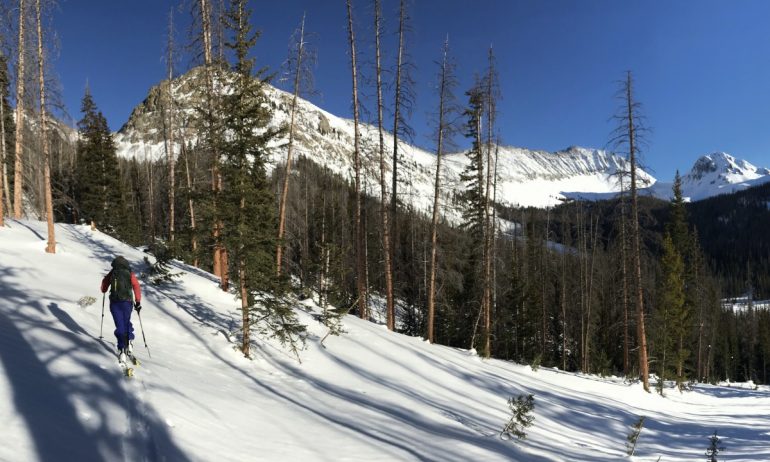
Breaking out of forest cover, we peered into the northern most peaks of Rocky Mountain National Park.
Finally the true saddle came into view. Evening light settled on the snow caps around us, splashing them gold. The coyote tracks had wandered elsewhere. We skinned up a wide, mellow bowl framed by 12,493 ft Mount Mahler and 12,945 ft Mount Richthofen. Steep couloirs began to reveal themselves in nearby ridgelines. The wind picked up, gusting against our backs as we started up a headwall. Skins and skis slipped on sastrugi. We switched to booting. I spotted dark brown pebbles — big horn sheep poop. We remarked on their hardiness to wander so high in winter.
The snow gave way to icy tundra grass and in short time we stood atop the saddle, just over 12,000ft. The chunky summit of Mount Mahler loomed impressive and imposing beside our perch. The peaks behind us glowed hot pink and gold. We gazed down at the frozen Lake Agnes due north, at the hard, wind packed cirque we’d ski to get to it. The skiing was better than expected. Smooth and fast. We met a series of rocky benches and short chutes which led us to the lake, solid as concrete. We skated and scooched across to where it drained into a half pipe between scree and summer trail that spit us out into a summer parking lot beside the historic Lake Agnes cabin.
The moon popped out above the turreted Noku crags. It threw soft shadows across the snow-packed summer road that made for a quick egress. Only a few rolling miles remained. We alternating between skating and scooching. Sam’s Voile Vector BC skis that had slowed her on descents turned into an efficient asset. I finally gave in to putting on skins while she let the fish scales on her bases climb the mellow rolls with ease. Moonlight washed the valley white. Stars unbothered by nearby cities winked. We found no more tracks then, only our own.
Manasseh Franklin is a writer, editor and big fan of walking uphill. She has an MFA in creative nonfiction and environment and natural resources from the University of Wyoming and especially enjoys writing about glaciers. Find her other work in Alpinist, Adventure Journal, Rock and Ice, Aspen Sojourner, AFAR, Trail Runner and Western Confluence.

